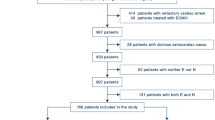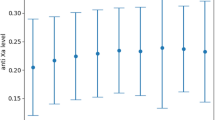Abstract
Purpose
Endoscopic third ventriculostomy (ETV) has gained traction as a method for treating post-hemorrhagic hydrocephalus of prematurity (PHHP) in an effort to obviate lifelong shunt dependence in neonates. However, data remains limited regarding inpatient failures.
Methods
A retrospective analysis of the NIS between 1998 and 2014 was performed. Discharges with age < 1 year and ICD-9-CM codes indicating intraventricular hemorrhage of prematurity (772.1x) and ETV/shunt (02.22 and 02.3x) were included. Patients with ICD-9-CM codes for ventricular drain/reservoir (02.21) were excluded to prevent confounding. Time trend series plots were created. Yearly trends were quantified using logarithmic regression analysis. Kaplan-Meier curves were utilized to analyze time to treatment failure. Time to failure for each treatment was compared using log-rank.
Results
A total of 11,017 discharges were identified. ETV was more likely to be utilized at < 29 weeks gestational age (p = 0.0039) and birth weight < 1000 g (p = 0.0039). Shunts were less likely to fail in older and heavier newborns (OR 0.836 p = 0.00456, OR 0.828 p = 0.0001, respectively). Those initially shunted had lower failure rates compared with ETV (OR 0.44, p < 0.0001) but time to failure was longer with ETV (p = 0.04562). 79.5% of ETVs that failed were shunted after the first failure. Shunts were much less likely to undergo ETV if they failed (OR 0.21, p < 0.0001). Higher grade IVH was predictive of shunt failure but not ETV (OR 2.36, p = 0.0129).
Conclusions
Although ETV can be effective in PHHP, it has a much higher initial failure rate than shunting and should thus be chosen based on a multifactorial approach.




Similar content being viewed by others
References
Mazzola CA, Choudhri AF, Auguste KI, Limbrick DD Jr, Rogido M, Mitchell L, Flannery AM, Pediatric Hydrocephalus Systematic R, Evidence-Based Guidelines Task F (2014) Pediatric hydrocephalus: systematic literature review and evidence-based guidelines. Part 2: Management of posthemorrhagic hydrocephalus in premature infants. J Neurosurg Pediatr 14(Suppl 1):8–23
Bock HC, Feldmann J, Ludwig HC (2018) Early surgical management and long-term surgical outcome for intraventricular hemorrhage-related posthemorrhagic hydrocephalus in shunt-treated premature infants. J Neurosurg Pediatr 22:61–67
Hanak BW, Bonow RH, Harris CA, Browd SR (2017) Cerebrospinal fluid shunting complications in children. Pediatr Neurosurg 52:381–400
Riva-Cambrin J, Kestle JR, Holubkov R, Butler J, Kulkarni AV, Drake J, Whitehead WE, Wellons JC 3rd, Shannon CN, Tamber MS, Limbrick DD Jr, Rozzelle C, Browd SR, Simon TD, Hydrocephalus Clinical Research N (2016) Risk factors for shunt malfunction in pediatric hydrocephalus: a multicenter prospective cohort study. J Neurosurg Pediatr 17:382–390
Demerdash A, Rocque BG, Johnston J, Rozzelle CJ, Yalcin B, Oskouian R, Delashaw J, Tubbs RS (2017) Endoscopic third ventriculostomy: a historical review. Br J Neurosurg 31:28–32
Lu L, Chen H, Weng S, Xu Y (2019) Endoscopic third ventriculostomy versus ventriculoperitoneal shunt in patients with obstructive hydrocephalus: meta-analysis of randomized controlled trials. World Neurosurg 129:334–340
(HCUP) HCaUP (2008) HCUP NIS Description of data elements. Agency for Healthcare Research and Quality. www.hcup-us.ahrq.gov/db/vars/hosp_teach/nisnote.jsp. Accessed Date Accessed 2008 Accessed
Barradas DT, Wasserman MP, Daniel-Robinson L, Bruce MA, DiSantis KI, Navarro FH, Jones WA, Manzi NM, Smith MW, Goodness BM (2016) Hospital utilization and costs among preterm infants by payer: nationwide inpatient sample, 2009. Matern Child Health J 20:808–818
Natarajan S, Lipsitz SR, Fitzmaurice GM, Sinha D, Ibrahim JG, Haas J, Gellad W (2012) An extension of the Wilcoxon rank-sum test for complex sample survey data. J R Stat Soc: Ser C: Appl Stat 61:653–664
Drake JM, Kulkarni AV, Kestle J (2009) Endoscopic third ventriculostomy versus ventriculoperitoneal shunt in pediatric patients: a decision analysis. Childs Nerv Syst 25:467–472
Kulkarni AV, Drake JM, Kestle JR, Mallucci CL, Sgouros S, Constantini S, Canadian Pediatric Neurosurgery Study G (2010) Endoscopic third ventriculostomy vs cerebrospinal fluid shunt in the treatment of hydrocephalus in children: a propensity score-adjusted analysis. Neurosurgery 67:588–593
Kulkarni AV, Drake JM, Kestle JR, Mallucci CL, Sgouros S, Constantini S, Canadian Pediatric Neurosurgery Study G (2010) Predicting who will benefit from endoscopic third ventriculostomy compared with shunt insertion in childhood hydrocephalus using the ETV success score. J Neurosurg Pediatr 6:310–315
Kulkarni AV, Hui S, Shams I, Donnelly R (2010) Quality of life in obstructive hydrocephalus: endoscopic third ventriculostomy compared to cerebrospinal fluid shunt. Childs Nerv Syst 26:75–79
Rasul FT, Marcus HJ, Toma AK, Thorne L, Watkins LD (2013) Is endoscopic third ventriculostomy superior to shunts in patients with non-communicating hydrocephalus? A systematic review and meta-analysis of the evidence. Acta Neurochir 155:883–889
Jernigan SC, Berry JG, Graham DA, Goumnerova L (2014) The comparative effectiveness of ventricular shunt placement versus endoscopic third ventriculostomy for initial treatment of hydrocephalus in infants. J Neurosurg Pediatr 13:295–300
Sacko O, Boetto S, Lauwers-Cances V, Dupuy M, Roux FE (2010) Endoscopic third ventriculostomy: outcome analysis in 368 procedures. J Neurosurg Pediatr 5:68–74
Elgamal EA, El-Dawlatly AA, Murshid WR, El-Watidy SM, Jamjoom ZA (2011) Endoscopic third ventriculostomy for hydrocephalus in children younger than 1 year of age. Childs Nerv Syst 27:111–116
Chamiraju P, Bhatia S, Sandberg DI, Ragheb J (2014) Endoscopic third ventriculostomy and choroid plexus cauterization in posthemorrhagic hydrocephalus of prematurity. J Neurosurg Pediatr 13:433–439
Weil AG, Fallah A, Chamiraju P, Ragheb J, Bhatia S (2016) Endoscopic third ventriculostomy and choroid plexus cauterization with a rigid neuroendoscope in infants with hydrocephalus. J Neurosurg Pediatr 17:163–173
Kulkarni AV, Sgouros S, Constantini S, Investigators I (2016) International infant hydrocephalus study: initial results of a prospective, multicenter comparison of endoscopic third ventriculostomy (ETV) and shunt for infant hydrocephalus. Childs Nerv Syst 32:1039–1048
Lim J, Tang AR, Liles C, Hysong AA, Hale AT, Bonfield CM, Naftel RP, Wellons JC, Shannon CN (2018) The cost of hydrocephalus: a cost-effectiveness model for evaluating surgical techniques. J Neurosurg Pediatr 23:109–118
Danilin VE, Letyagin GV, Kim SA, Sysoeva AA, Amelina EV (2018) Factors of endoscopic third ventriculostomy efficacy in infants with obstructive hydrocephalus under one year of age. Zh Vopr Neirokhir Im N N Burdenko 82:59–67
Behjati S, Emami-Naeini P, Nejat F, El Khashab M (2011) Incidence of hydrocephalus and the need to ventriculoperitoneal shunting in premature infants with intraventricular hemorrhage: risk factors and outcome. Childs Nerv Syst 27:985–989
Gilard V, Chadie A, Ferracci FX, Brasseur-Daudruy M, Proust F, Marret S, Curey S (2018) Post hemorrhagic hydrocephalus and neurodevelopmental outcomes in a context of neonatal intraventricular hemorrhage: an institutional experience in 122 preterm children. BMC Pediatr 18:288
Wagner W, Koch D (2005) Mechanisms of failure after endoscopic third ventriculostomy in young infants. J Neurosurg 103:43–49
Bakshi R, Kamran S, Kinkel PR, Bates VE, Mechtler LL, Belani SL, Kinkel WR (1999) MRI in cerebral intraventricular hemorrhage: analysis of 50 consecutive cases. Neuroradiology 41:401–409
Strahle J, Garton HJ, Maher CO, Muraszko KM, Keep RF, Xi G (2012) Mechanisms of hydrocephalus after neonatal and adult intraventricular hemorrhage. Transl Stroke Res 3:25–38
Javadpour M, Mallucci C, Brodbelt A, Golash A, May P (2001) The impact of endoscopic third ventriculostomy on the management of newly diagnosed hydrocephalus in infants. Pediatr Neurosurg 35:131–135
Christian EA, Jin DL, Attenello F, Wen T, Cen S, Mack WJ, Krieger MD, McComb JG (2016) Trends in hospitalization of preterm infants with intraventricular hemorrhage and hydrocephalus in the United States, 2000-2010. J Neurosurg Pediatr 17:260–269
Dani C, Corsini I, Bertini G, Fontanelli G, Pratesi S, Rubaltelli FF (2010) The INSURE method in preterm infants of less than 30 weeks’ gestation. J Matern Fetal Neonatal Med 23:1024–1029
Shah AH, Ibrahim GM, Sasaki J, Ragheb J, Bhatia S, Niazi TN (2018) Multiple echocardiography abnormalities associated with endoscopic third ventriculostomy failure. J Neurosurg Pediatr 21:25–30
Cronqvist S, Granholm L, Lundstrom NR (1972) Hydrocephalus and congestive heart failure caused by intracranial arteriovenous malformations in infants. J Neurosurg 36:249–254
Hooper R (1961) Hydrocephalus and obstruction of the superior vena cava in infancy. Clinical study of the relationship between cerebrospinal fluid pressure and venous pressure. Pediatrics 28:792–799
Lipina R, Reguli S, Dolezilova V, Kuncikova M, Podesvova H (2008) Endoscopic third ventriculostomy for obstructive hydrocephalus in children younger than 6 months of age: is it a first-choice method? Childs Nerv Syst 24:1021–1027
Cinalli G, Salazar C, Mallucci C, Yada JZ, Zerah M, Sainte-Rose C (1998) The role of endoscopic third ventriculostomy in the management of shunt malfunction. Neurosurgery 43:1323–1327 discussion 1327-1329
Neils DM, Wang H, Lin J (2013) Endoscopic third ventriculostomy for shunt malfunction: what to do with the shunt? Surg Neurol Int 4:3
Peretta P, Ragazzi P, Carlino CF, Gaglini P, Cinalli G (2007) The role of Ommaya reservoir and endoscopic third ventriculostomy in the management of post-hemorrhagic hydrocephalus of prematurity. Childs Nerv Syst 23:765–771
Siomin V, Cinalli G, Grotenhuis A, Golash A, Oi S, Kothbauer K, Weiner H, Roth J, Beni-Adani L, Pierre-Kahn A, Takahashi Y, Mallucci C, Abbott R, Wisoff J, Constantini S (2002) Endoscopic third ventriculostomy in patients with cerebrospinal fluid infection and/or hemorrhage. J Neurosurg 97:519–524
Author information
Authors and Affiliations
Corresponding author
Ethics declarations
All procedures performed in studies involving human participants were in accordance with the ethical standards of the institutional and/or national research committee and with the 1964 Helsinki declaration and its later amendments or comparable ethical standards. The consent process was waived since it was a retrospective study of patient data stripped of all identifying information.
Conflict of interest
The authors declare that they have no conflicts of interest.
Additional information
Publisher’s note
Springer Nature remains neutral with regard to jurisdictional claims in published maps and institutional affiliations.
Electronic supplementary material
ESM 1
(DOCX 52 kb)
Rights and permissions
About this article
Cite this article
Luther, E., McCarthy, D., Sedighim, S. et al. Endoscopic third ventriculostomy inpatient failure rates compared with shunting in post-hemorrhagic hydrocephalus of prematurity. Childs Nerv Syst 36, 559–568 (2020). https://doi.org/10.1007/s00381-019-04465-w
Received:
Accepted:
Published:
Issue Date:
DOI: https://doi.org/10.1007/s00381-019-04465-w




